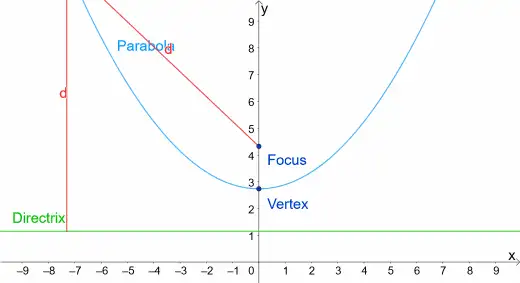The graph looks like this. You can simply plug some points to see the curve of the graph. Or pull out your graphing calculator:
 There is a minimum or maximum y value for a parabola, at a point called the vertex. In this parabola the vertex at (0,0). If a is negative you have a upside-down parabola.
There is a minimum or maximum y value for a parabola, at a point called the vertex. In this parabola the vertex at (0,0). If a is negative you have a upside-down parabola.
If you rewrite the equation in this vertex form: y = a(x-h)2+k, you have a parabola with vertex on (h,k).
Finding the vertex
Given the standard form, the x-coordinate of the vertex is given by| x = -b/2a |
This is a result of the quadratic formula. x = -b/2a is exactly in the middle of the 2 solutions and is the x-coordinate of the vertex. For the y-coordinate, just plug the x coordinate in and solve for y.
[Insert Example]
The parabola actually has an geometric definition, defined based on a straight line (called the directrix) and a point (called the focus). Definition A parabola is the set of all the points equal distant from a focus point to the directrix line. Let d be the common distance from the focus to the parabola and from the parabola to the directrix line.
The vertex is an obvious point on the parabola, on the line of symmetry, exactly in the middle between the focus and the directrix with d here being the smallest. Let's call this distance f, the focal length.
The focal length determines the shape of the parabola. The distance from the vertex to the focus is f. From the vertex to the directrix is also f.
For simplicity, let the directrix be at y = -f and focus at (0,f). and freeze one frame for a moment at any P at (x,y).
[insert picture]
Then the vertical red line has length of y + f. Then from P to the Focus, by the distance formula, the length is
sqrt( (y - a)2 + x2). They must be equal:
sqrt( (y - f)2 + x2) = y + f
Let d be the common distance from the focus to the parabola and from the parabola to the directrix line.
The vertex is an obvious point on the parabola, on the line of symmetry, exactly in the middle between the focus and the directrix with d here being the smallest. Let's call this distance f, the focal length.
The focal length determines the shape of the parabola. The distance from the vertex to the focus is f. From the vertex to the directrix is also f.
For simplicity, let the directrix be at y = -f and focus at (0,f). and freeze one frame for a moment at any P at (x,y).
[insert picture]
Then the vertical red line has length of y + f. Then from P to the Focus, by the distance formula, the length is
sqrt( (y - a)2 + x2). They must be equal:
sqrt( (y - f)2 + x2) = y + f (y - f)2 + x2 = (y + f)2
y2 - 2fy + f 2 + x2 = y2 + 2fy + f 2
The y2 and f 2 cancel, bring the - 2fy to the right hand side, leaving:
| x2 = 4 f y |
Or
| y = 1/(4f) x2 |
Latus Rectum
The latus rectum is the line segment parallel to the directrix that goes through the focus with endpoints on the parabola.
And the length of the latus rectum is 4f. Here is why:
At the right endpoint of the latus rectum, y = f. Let's solve for x so we know half the length of the latus rectum. Plug that in: x2 = 4f 2. So x = 2f. The right endpoint is (2f,f). The left endpoint is (-2f, f). So length of the latus rectum is 4f.Vertex-Focal Length Form
The equation y = 1/(4f) x2 is the simple case where the vertex at (0,0). For general case, the vertex at (h,k) form is:| (x - h)2 = ± 4 f (y - k) |
| (y - h)2 = ± 4 f (x - k) |
When you are given a parabola in standard form, it is only straight forward to find the x-coordinate of the vertex which is x = -b/2a. It is not so straight forward to find the focus or the directrix.
However, you can rewrite the standard form into the vertex form (by completing square), so you can read off both coordinates of the vertex (h, k) and calculate the focal length f. With the focal length, you can find the directrix line and the focus point, which is just a focal length away from the vertex. The x-coordinate of the focus will be same as the vertex's x-coordinate. Each end of the latus rectum is 2 focal lengths away from the focus, with same y-coordinate as the focus. [Insert Example]
No comments:
Post a Comment